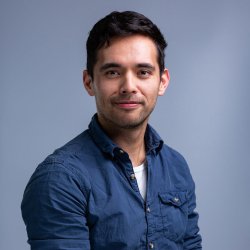PGR IAA Officer Spotlight - Nicole Luc
Nicole Luc, a PGR from the Centre for Environment and Sustainability has been helping us capture the outputs and impact of Surrey's EPSRC IAA projects. Let's hear about her experience...
Tell us about yourself, why you applied for this role, and what you expected to gain
At the time of application for the role as an IAA officer, I was in the first year of my PhD within the Centre for Environment and Sustainability. Prior to beginning my PhD, I had worked under Dr. Zoe Harris as a Research Assistant as part of Phase 1 of the Biomass Feedstock Innovation Programme, where I got a taste of the development of innovation and commercialisation of technology. The experience highlighted to me the importance of scale and bridging the disconnect between pure research and innovation to bring about real impact, particularly in problem-orientated fields such as Sustainability.
I became interested in applying for the IAA officer role due to the commitment the Innovation Strategy team has to tracking and advancing the impact of research within the university. The role offered me the prospect to gain valuable insight into the process of writing successful funding applications and identifying the hallmarks of an innovative project, and observe how such projects develop. Additionally, being an IAA officer provided a unique opportunity to liaise directly with the academics leading the IAA-funded projects and learn from them.
My time as an IAA officer has highlighted the importance of collaboration and knowledge exchange in the realisation and maximising impact of a given innovation
How would you define ‘innovation’, how does it fit within an academic environment, and how is it relevant? Has your definition changed since working in this role?
I would define innovation as novel solutions that advance civilisation or technology. Whilst often intended as problem-oriented solutions, innovation may not always be deliberate, such as in the cases of accidental discoveries of penicillin and plastic. Given the right circumstances, discoveries can even be extended far beyond its intended purpose. Academic environments are often where pioneering research is occurring, and thus often the brewing point of innovation, but my time as an IAA officer has also highlighted the importance of collaboration and knowledge exchange in the realisation and maximising impact of a given innovation.
What do you think are the biggest barriers to innovation for researchers at Surrey, in particular within your School or Faculty, and how do you suggest we address these?
The Centre for Environment and Sustainability which I am a part of has had a wonderful culture of encouraging interdisciplinary collaboration and engendering impact for the cause of sustainability since its inception. However, as is common within academia, there can be a disconnect between conducting research and the implementation/dissemination of the research to maximise impact that is so key for innovation. In particular, the way that innovation and impact can be assessed is unclear, so a good first step to help academics in understanding innovation is to offer training to address this.
How has your experience in the role changed your approach to innovation?
The experience of being an IAA officer has given me insight into both quantitative and qualitative approaches in assessing the impact of a given innovation. For example, measuring quantitative metrics such as number of policy changes, or number of new products and processes created gives a systematic way to compare the impact of different projects. Capturing qualitative measures such as the reception of a given product then provides additional details that are not easily quantified, but can provide an added context.
What things have you learned? Was anything unexpected?
I have learnt how important the proof-of-concept stage is for the development of any given innovation. Having the freedom to plan, test and fail early is an underappreciated advantage which is often prevented by funders being unwilling to take risks on novel projects. Small grants such as funding through IAA can therefore often be instrumental in bridging this gap and has, on many occasions, allowed researchers to demonstrate the viability of their ideas and subsequently secure larger amounts of funding
My exposure to the many projects that have received IAA funding has additionally given me insight into how to write effective grant bids, which will no doubt be invaluable to my development as an academic.
What would you say to a prospective ECR considering applying to work with the technology transfer team?
Working within the Innovation team is a unique opportunity to witness the inner workings of both funders and researchers. I have learnt a great deal about innovation and maximising impact of research from my time as an IAA officer, and would absolutely recommend the experience to a prospective ECR.
Question | 😱 | 😢 | 😐 | 🤓 | 🔥 |
|---|---|---|---|---|---|
Before your IAA Officer role, what was your practical understanding and application of impact, knowledge exchange and commercialisation activities? |
|
| ❌ |
| |
Before your IAA Officer role, what was your understanding of IP? | ❌ |
|
|
|
|
Before your IAA Officer role, what was your awareness for the relevance of innovation to the academic career? |
|
|
| ❌ |
|
Overall, how do you feel about Innovation now? | ✅ |

